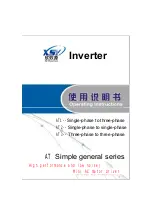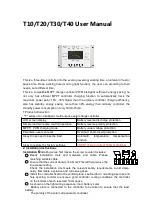
©
2009 Magnum Energy Inc
Page 22
2.4 AC Wiring
This section provides information on how to make the AC connections to the inverter using the
correct AC wire size and corresponding overcurrent protection. Refer to
fi
gure 2-13 for an over-
view of the AC wiring.
2.4.1 Pre-AC Wring Requirements
CAUTION:
Before installing any AC wiring, review the safety information at the begin-
ning of this manual and the following to ensure a safe and long-lived system:
AC Loads powered by the inverter will need to installed into an electrical panel.
Read all instructions and cautionary markings located at the beginning of this manual
and in the pre-installation section, before installing the inverter and batteries.
Always use properly rated circuit-breakers. If using an electrical sub-panel, circuit
breakers can be moved from the main electrical panel to the sub-panel only if the
breakers are also listed to be installed in the sub-panel.
AC wiring must be no less than #10 AWG (5.3 mm
2
) gauge copper wire and be ap-
proved for residential wiring per the NEC (THHN as an example).
DO NOT connect the inverter’s output to an AC power source.
Listed or labeled equipment shall be installed and used in accordance with any in-
structions included in the listing or labeling.
•
•
•
•
•
•
2.4.2 AC Wire Size and Overcurrent Protection
The AC input and output wiring must be sized
per the NEC and
local electrical safety code require-
ments
to ensure the wires ability to safely handle the inverter’s
maximum load current. After
determining the proper AC wire sizes, the inverter’s AC input and output wires are required to be
protected
from short circuits and overloads by an overcurrent protection device
and have a means
to disconnect the AC circuits.
Overcurrent protection is not included in the inverter and must be provided as part of the instal-
lation.
The overcurrent protection device must be a circuit breaker or a fuse
and
be properly sized
and branch circuit rated for the wire it is protecting and the appliances being powered.
The MS-PAE series provides a terminal block (see
fi
gure 2-12) that allows the AC input and out-
put wiring to be
permanently wired. This terminal block allows a
service/distribution panel (main
panel) to be wired to the inverter’s input and a dedicated panel (sub-panel) between the inverter’s
output wiring and the AC loads. These systems use the circuit breakers provided in the panels as
the overcurrent protection and the AC disconnect device.
When in the Standby mode, the full AC continuous pass-thru capacity of the MS-PAE Series in-
verter/charger is 30 amps for each AC leg (AC HOT 1 and AC HOT 2). To obtain the 30 amp con-
tinuous pass-thru capability of the inverter, each AC HOT input to the inverter requires a 30 amp
continuous duty rated double-pole breaker
1
, which corresponds to a minimum cable size of #10
AWG
2
in conduit. If you are using other wire sizes, refer to the appropriate electrical codes for
circuit breaker requirements.
CAUTION:
The inverter’s internal AC transfer relay is rated for 30 amps (each leg),
the pass-thru current must be no greater than 30 amps or damage to this relay may
occur.
Note 1 - The breaker must be derated by 80% if not rated for continuous duty. The NEC requires that cir-
cuits are not to be operated continuously at more than 80% of rating unless listed with a 100% continuous
rating.
Note 2 - Copper wire rated with 90°C insulation at an ambient temperature of 30°C (86°F).
Installation
















































